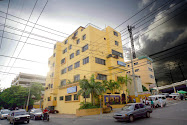
Perhaps this disaster represents the greatest accumulation of orthopaedic injuries to ever occur in one place at one time. Here in
Team members were:
Steve Bostian –
Lucia Hernandez RN
Scott Nelson MD - Orthopaedic Surgery
Susan Beemer RN – anesthetist
Dielika grew up in PAP and was able to get a single text message through to Johnny Boulos a friend of her brother. After circling the airstrip 20 times we were able to get clearance to land the plane for 3 minutes. We made a steep descent and dumped our equipment onto the airfield and our pilot quickly returned to the air. Fortunately, Johnny had waited for us all afternoon and was there to greet us. To make a long story short we are indebted to the entire Boulos family for their hospitality and generosity in facilitating everything that we were able to accomplish during the last 2 weeks.
We initially made some brief visits to assess the operating facilities at approximately 6 different hospitals. 48-72 hours after the quake there was still not a single operation going on at any of the hospitals that we visited except for Hopital Adventiste d’Haiti where the innovative local medical director had created an operating room tent out of surgical drapes and was performing life saving amputations in front of the hospital. His nurse in the yellow short sleeve dress had just returned to work. She had been comforting her 10 year old son for who was trapped under a cement girder for 36 hours after the quake. A UN crane finally had come to free him and as the heavy cement girder was lifted it slipped from the grip of the crane… Another worker was at the hospital looking for 8 body bags for her family members. At every facility there were hundreds of languishing patients, most of whom were laying outside due to fear of aftershocks. Many of them were developing gangrene, some dying, and others already dead. It was utter chaos and no help was in sight. Where should we start…
With promises to return and help Dr. Archer, the medical director at
After 24 hours of operating, a team from the Hospital for Special Surgery in
During the first few days the situation went from bad to worse. The many injured patients were developing infections and gangrenous limbs faster than we could operate. A couple days after we began operating the stench of death strengthened and permeated the hallways and courtyards of the hospital. Dead limbs still attached to patients, dead bodies, and amputated parts all contributed. Slowly we were able to overcome this and each day the hospital seemed to metamorphose. Patients were operated, volunteers showed up with bleach, halls were cleaned and chaos was organized little by little. An entire hospital infrastructure was to be created in the ensuing days. Masking tape was used on the foreheads of the victims to delineate OR 1 – emergent cases, or OR 2 – operative but less emergent cases. The first 4 days were spent operating only on OR 1’s which consisted of open fractures, compartment syndromes, and treating severe open wounds and infections.
Wednesday morning one week after the quake the 6.1 aftershock hit and all the patients rapidly cleared the hospital building. We took advantage of the situation by mopping the halls and slowly bringing all the patients back in to the building one by one in an organized fashion. Luckily we had arisen 15 minutes before the shock as part of the cement wall above our heads had collapsed where we had been lying.
Over a period of one week we were able to convert several adjacent rooms into operating rooms and the 2 room OR suite became a 6 room operating facility where we coordinated surgical volunteers from all over the
We continue in collaboration with the Hopital Adventiste d’Haiti where the situation is very similar to the Hopital de la Communaute Haitien. The arrival of Dr. Brad Walters from
It did become necessary to place armed security at the entrance of the hospital and other strategic locations to provide crowd control and resolve some looting that began to take place as food and supplies arrived on site. However, I personally never felt unsafe and would dare to say that with the additional military and NGO presence, most parts of Port au Prince may be more secure now than they have been in a long time. Of course many render my opinions on security as worthless as they consider me to have a lack of risk aversion.
It was a trip of physical endurance, emotional intensity, and spiritual contemplation. It brought my mind back to a scene several years ago of one of our Haitian patients who fell asleep with her Bible open to Psalm 46.
God is our refuge and strength,
an ever present help in trouble.
Therefore we will not fear, though the earth give way and the mountains fall into the heart of the sea, though its waters roar and foam and the mountains quake with their surging.
Ps 46:1-3
On January 25 I returned to
I would like to acknowledge the efforts of our team members not mentioned above who were also working day and night to support the efficiency of our operation both in Port au Prince and around the world. These in include my wife Marni in Santo Domingo, Robbie Jackson - Cure DR, Erin Card - Cure US, Jeff Douglas and Andrew Haglund in Port au Prince and the many other medical personnel who rapidly activated the delivery of their expertise and medical supplies.
To see more images click here (some may be graphic)





















